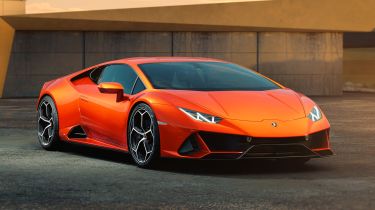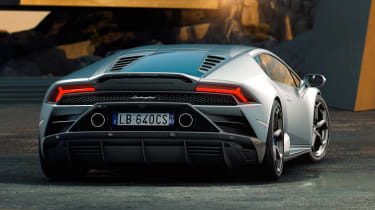Lamborghini Huracan Evo: price, specification, on-sale date
Latest Huracan gets sharper chassis that can predict the driver's next move
These are the first pictures of the Lamborghini Huracan Evo, a thoroughly updated version of the Italian supercar that will go head-to-head with the Ferrari 458 Pista.
Costing from around £198,000 and arriving this spring, the V10-engined Huracan Evo boasts improved aerodynamics and a more sophisticated chassis, along with interior upgrades to keep occupants connected.
Carbuyer's best supercars on sale now
Described as "the next generation V10 supercar", the Evo is based on the Lamborghini Huracan Performante, with the same 631bhp 5.2-litre engine. The naturally aspirated engine revs to 8,000rpm and uses four-wheel drive to help launch it from 0-62mph in 2.9 seconds. It gets to 125mph in nine seconds and has a top speed of more than 202mph.
However, it's the chassis that has undergone the most scrutiny. The Huracan Evo is the first Lamborghini with 'predictive logic' for the on-board computers, which control how it behaves at the limit. Using rear-wheel steering and by sending power between individual wheels, Lamborghini claims the Evo can "anticipate the next move and needs of the driver, interpreting this into perfect driving dynamics."
Accelerometers and gyroscopes monitor the car's behaviour, while sensors relay the steering, braking and throttle inputs to adjust the car accordingly. The level of response depends on which driving mode is selected: Anima, Strada, Sport or Corsa (which means 'race' in Italian), step up how aggressively the system works.
Design changes include a new front bumper with a larger spoiler to generate extra downforce. The enlarged air intakes are also styled in the Ypsilon shape that's a recurring theme around the Huracan and other Lamborghinis. New 20-inch Aesir alloy wheels are specific to the Evo and the car also gets a new four-layer orange paint finish and new side air intakes. The tail is inspired by the Huracan racing car, with high-set twin exhaust pipes and a larger rear spoiler. All told, bodywork changes are said to improve downforce and aerodynamic efficiency by 500% compared with the first-generation Huracan.
Technology hasn't just been limited to going faster; a new 8.4-inch touchscreen also brings the centre console up to date. It's used to program the climate control and heated seats, as well as the infotainment system, and comes with Apple CarPlay and Siri voice assistant compatibility. Owners can also choose an optional telemetry system that uses two cameras and on-board data to record driving performance for analysis.
Further options include two-tone and Alcantara upholstery, carbon forged trim and ambient lighting. Style packs will also be offered to personalise the Huracan Evo to each customer's taste.
Most Popular
Tips & advice

Car dashboard warning lights: what does each symbol mean?

Electric car charging stations: public networks, charger types, apps and maps








